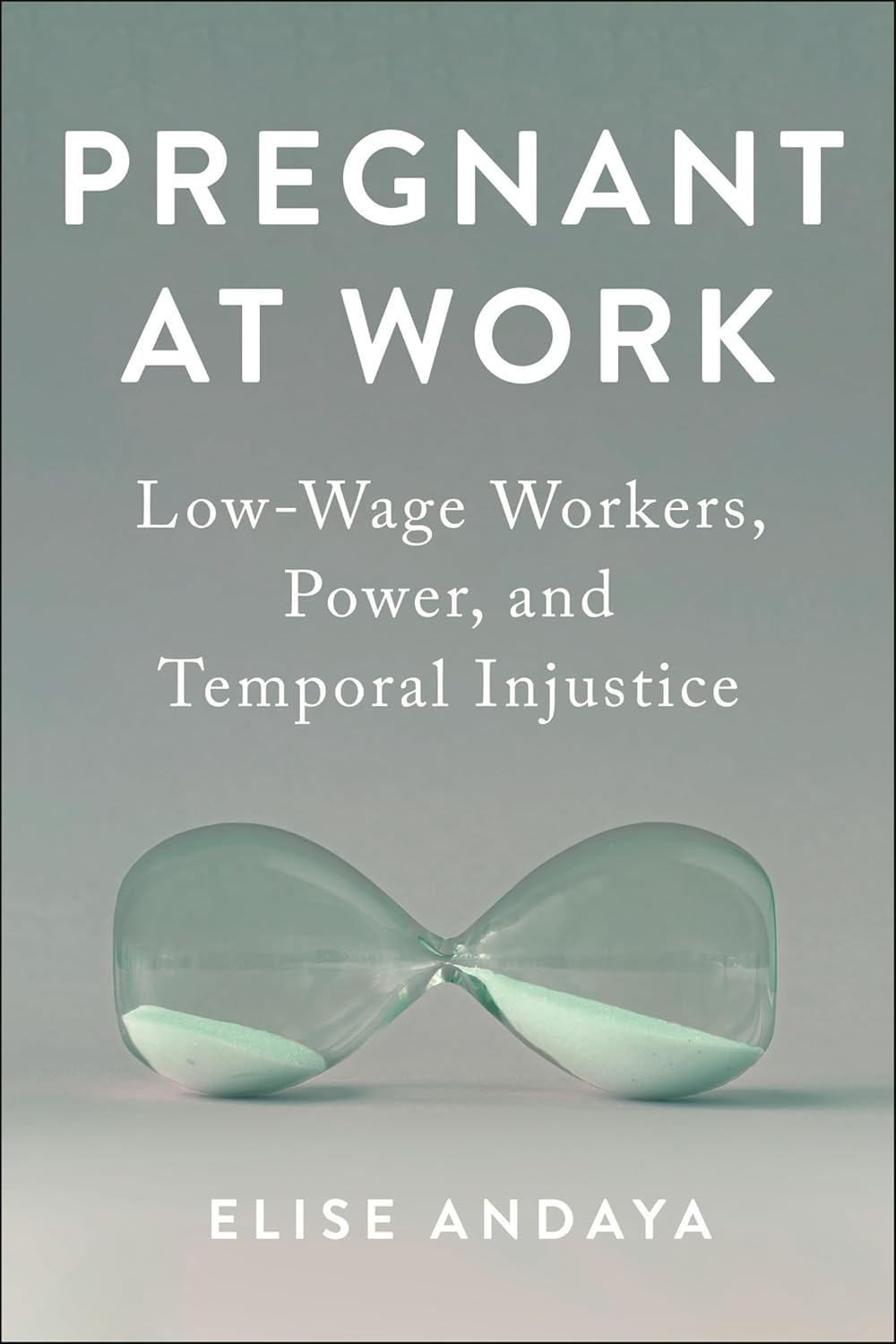
Review by Heather Duerre Humann, Florida Gulf Coast University
Publisher: New York University Press, 2024
Length: 208 pages
Given the fact that service industry work requires flexible and round-the-clock availability (not to mention periods when workers are expected to be “on call”), the reality that many employers in that sector offer limited or no time off for sick or parental leaves, and the necessity for pregnant women to schedule and attend frequent medical appointments—where there can be long wait-times to see their primary care providers—low-wage workers in service fields often find themselves in particularly vulnerable positions. Their plight is the focus of Elise Andaya’s recently published book, Pregnant at Work: Low-Wage Workers, Power, and Temporal Justice. In this study, she examines the factors that contribute to the social inequities faced by pregnant service workers in New York City. Comprised of an Introduction, four chapters (which provide ethnographic accounts), and an Epilogue, Andaya’s study investigates the myriad struggles faced by this segment of the workforce as well as the socio-cultural factors that contribute to their predicaments.
As a point of departure, Andaya highlights in the book’s Introduction how the service sector, a rapidly growing employment field in the nation’s economy, relies on low-wage workers, a majority of whom are minority women. As Andaya explains, the service sector’s “dramatic increase as a share of the economy has been fueled, on the one hand, by the late twentieth-century expansion of the knowledge industries and government services that employ so-called ‘white-collar’ workers and, on the other, by the decline in American manufacturing that forced ‘blue-collar; workers into the rapidly growing low-wage service industries” (p. 7). Service industry jobs are notoriously low paying, yet workers gravitate to that employment sector for a variety of reasons including that these individuals’ work experience, skills, education, and (sometimes) immigrant status bars them from jobs that pay more. In the chapters that follow, Andaya, who conducted interviews and fieldwork in a prenatal clinic of a public hospital in New York City, vividly illustrates workers’ struggles and their attempts to navigate the demands of service work while balancing their own need to receive adequate prenatal care.
In Chapter 1, “Service Labor and Temporal Governance in the ‘City That Never Sleeps,’” Andaya situates her examination in New York City and addresses the perception that service-industry work is low-skilled labor performed principally by women and people of color. Andaya also illustrates what she refers to as the “regimes of labor time” in various kinds of service industry work (p. 29). As part of this discussion, Andaya highlights the rigid time demands imposed on service industry workers and notes how demanding work schedules contribute to workers’ difficult situations.
In the next chapter, “Working While Pregnant: Conflicts between Labor, Clinical, and Gestational Time,” Andaya calls particular attention to the lived experiences of pregnant service workers. This allows her to showcase the precarious positions that pregnant workers so frequently occupy since they must navigate demanding work schedules with the need for prenatal care. Indeed, she describes the difficulties experienced by pregnant workers who must try to strike a balance between fulfilling the expectations of their employers while also attending to their own (prenatal) medical needs—a difficulty further compounded by the nontraditional work hours of many in the service industry and made worse still because there are all-too-often long wait-times at the prenatal clinics they visit for care.
The lived experiences of the pregnant workers that Andaya interviews form the backbone of the book’s third chapter, “Clinical Time and Racialized Inequality in Safety Net Prenatal Care.” Her analysis results from ethnographic research she conducted at Beaumont Hospital’s prenatal clinic. Drawing from interviews and conservations with the clinic’s patients and providers, Andaya concludes that, due to their chronic underfunding and the racialized system in which they operate, safety net institutions exacerbate inequities for low-wage service workers.
In “Cosmologies of Care: Temporal Justice and the Politics of Value,” the book’s fourth and final chapter, Andaya addresses debates surrounding the politics of care and value. She points out that, rather than referencing these issues as matters of “rights,” pregnant service workers instead interpret their supervisors’ willingness to make accommodations as a matter of care. Andaya also connects the issue of employees’ access to time off with the concept of social justice.
A focus on social justice likewise informs the book’s Epilogue, which includes an update that takes account of the post-Covid landscape. Andaya discusses how, despite Covid re-framing concepts surrounding work, the service industry did not adjust to workers to the same degree that other industries were forced to. Remote work, which became the norm for many in other employment sectors, was rarely offered to service workers. Thus, the inequities they faced continued, and in some cases, worsened, during and even after the pandemic. Observations such as these show how pregnant workers in the service industry remain vulnerable.
In this and other respects, Andaya’s carefully researched and well-organized study shines a light on the inequities faced by pregnant service-industry workers. Due to the way Andaya’s examination calls attention to the intersection of low-wage service workers’ struggles and the specific needs of pregnant women, Pregnant at Work: Low-Wage Workers, Power, and Temporal Injustice fills an important niche within the field of Women’s Studies. Thus, the book should be of interest to scholars in the field and could also prove to be a worthwhile textbook in upper-level or graduate Women’s Studies courses.
Heather Duerre Humann teaches in the Department of Language and Literature at Florida Gulf Coast University. The author of five books including Gender Bending Detective Fiction, her research focuses on gender issues and cultural studies. She is on the Editorial Board of two peer-reviewed journals, Margaret Atwood Studies and Studies in American Culture.
